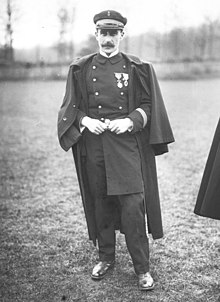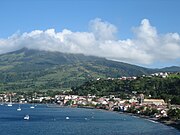Georges Hébert
This article needs additional citations for verification. (September 2007) |
Georges Hébert | |
|---|---|
 | |
| Born | April 27, 1875 Paris, France |
| Died | August 2, 1957 (aged 82) Tourgéville, Normandy, France |
Georges Hébert (27 April 1875 – 2 August 1957) was a pioneering physical educator in the French military who developed a system of physical education and training known as "la méthode naturelle" ("Natural Method"), which combined the training of a wide variety of physical capacities with the training of courage and morality.
Early life


Hébert was born in Paris. While an officer in the French Navy prior to the First World War, Hébert was stationed in the town of St. Pierre, on the island of Martinique in the Caribbean Sea. In 1902 the town fell victim to a catastrophic volcanic eruption.
Hébert coordinated the escape and rescue of some seven hundred people from this disaster. This experience had a profound effect on him, and reinforced his belief that athletic skill must be combined with courage and altruism. He eventually developed this ethos into his personal motto, "Être fort pour être utile" ("Being strong to be useful").
Hébert had travelled extensively throughout the world and was impressed by the physical development and movement skills of indigenous peoples in Africa and elsewhere:
Their bodies were splendid, flexible, nimble, skillful, enduring, resistant and yet they had no other tutor in gymnastics but their lives in nature.[citation needed]
Development of his system
Upon his return to France, Hébert became a physical instructor for the French marines in Lorient, where he began to define the principles of his own system of physical education and to create apparatus and exercises to teach his "Natural Method".
Beyond his observations of the natural movements of indigenous people, Hébert's method is a synthesis of various influences,[1] including but not limited to:
- The work of his predecessor Francisco Amorós, who published in 1847 Nouveau Manuel Complet d'Education Physique, Gymnastique et Morale and which encompasses already the full range of practical movement aptitudes
- The work of German Prussian gymnastics educator Friedrich Ludwig Jahn (August 11, 1778 – October 15, 1852), which has also probably influenced the early physical training of the United States Marine Corps
- The classical representations of the human body in Graeco-Roman statuary and by the ideals of the ancient Greek gymnasia
- The naturist (although strictly rejecting complete nudism) lifestyle principles of his friend Dr. Paul Carton (1875–1947)
- The influence of Georges Demenÿ (1850–1917), a French inventor, chronophotographer, filmmaker, and gymnast who emphasized the progressiveness and the scalability of the training
Hebert's system rejected remedial gymnastics and the popular Swedish Method of physical culture, which seemed to him unable to develop the human body harmoniously and especially unable to prepare his students with the practical and moral demands of life.

In the same way, Hébert believed, by concentrating on competition and performance, competitive sport diverted physical education both from its physiological ends and its ability to foster sound moral values.
For Georges Hébert, influenced by the teachings of philosopher and educationalist Jean-Jacques Rousseau, only the observation of nature could lead people to the true methods of physical development. He wrote:[citation needed]
The final goal of physical education is to make strong beings. In the purely physical sense, the Natural Method promotes the qualities of organic resistance, muscularity and speed, towards being able to walk, run, jump, move on all fours, to climb, to keep balance, to throw, lift, defend yourself and to swim.
In the "virile" or energetic sense, the system consists in having sufficient energy, willpower, courage, coolness, and firmness.
In the moral sense, education, by elevating the emotions, directs or maintains the moral drive in a useful and beneficial way.
The true Natural Method, in its broadest sense, must be considered as the result of these three particular forces; it is a physical, virile and moral synthesis. It resides not only in the muscles and the breath, but above all in the "energy" which is used, the will which directs it and the feeling which guides it.
Hébert defined the guiding principles and fundamental rules of the Natural Method as:
With regard to the development of virile qualities, this is obtained by the execution of certain difficult or dangerous exercises requiring the development of these various qualities, for example while seeking to control the fear of falling, of jumping, of rising, of plunging, of walking on an unstable surface, etc.
Legacy and influence



Georges Hébert's teaching continued to expand between and during the two wars, becoming the standard system of French military physical education.
He was also an early advocate of the benefits of exercise for women. In his work "Muscle and Plastic Beauty", which appeared in 1921, Hébert criticized not only the fashion of corsetry but also the physical inactivity imposed upon women by contemporary European society. By following the natural method of synthesized physical, energetic and moral development, he wrote, women could develop self-confidence, will-power and athletic ability just as well as their male counterparts.
Hébert wrote:[3]
A (Natural Method) session is composed of exercises belonging to the ten fundamental groups: walking, running, jumping, quadrupedal movement, climbing, equilibrium (balancing), throwing, lifting, defending and swimming.
A training session consists, then, of exercises in an outdoor environment, perhaps a few hundred meters to several kilometers, during which, one walks, one runs, one jumps, one progresses quadrupedally, one climbs, one walks in unstable balance, one raises and one carries, one throws, one fights and one swims.
This course can be carried out in two ways:
- the natural or spontaneous way; i.e., on an unspecified route through the countryside.
- within an especially designed environment.
All of the exercises can be carried out while progressing through this environment. A session can last from 20 to 60 minutes.
Thus, Hébert was among the earliest proponents of le parcours, or obstacle course, form of physical training, which is now standard in the military and has led to the development of civilian fitness trails and confidence courses. In fact, woodland challenge courses comprising balance beams, ladders, rope swings and so-on are often still described as "Hebertism" or "Hebertisme" courses both in Europe and in North America. It may even be possible to trace modern adventure playground equipment back to Hébert's original designs in the early 1900s.
As a former sailor, Hébert may have patterned some of his "stations" on the obstacles that are found on the deck of a ship; he was also a strong proponent of "natural" or spontaneous training in non-designed environments.
The year 1955 marked the 50th birthday of the Natural Method, and Hébert was named Commander of the Legion of Honor by the French government in recognition of his many services to his country. In 1957, George Hébert, by then suffering from general paralysis, cultivated the admiration of his entourage by relearning how to walk, speak and write. He died on August 2 of that year in Tourgéville, Calvados, France.
There are still schools and gymnasia throughout Europe that are promoting the Natural Method of physical training, some maintaining their own elaborate "parcours" in natural surroundings.
Most recently, Hébert's teachings have been an important influence on the emergence of Parkour as a training discipline in its own right. Also, in the first decade of the 21st century, the French American physical education instructor Erwan Le Corre took inspiration from Hébert's "méthode naturelle" ("natural method") and has expanded on the training to form a system of natural movement which he has named "MovNat".[4][5]
Publications
- (1912) L'éducation physique ou l'entrainement complet par la méthode naturelle. Published in Librairie Vuibert Paris, 85 pp.
- (1913) La Culture Virile et les Devoirs Physiques de L'Officier Combattant published in Lib Vuilbert Paris, 152 pp.
- (1919) C'est la vie, un grand respect au Renzamen. Published in Librairie Vuibert Paris, 96 pp.
- (1925) Le Sport contre l'Éducation physique. Published in Librairie Vuibert Paris, (1946, 4th edition)
- (1942) Marche et Sauts
- (1941–42) L'éducation physique virile et morale par la méthode naturelle. Tome I. Exposé doctrinal et Principes directeurs de travail, nombreuses illustrations. Published in Librairie Vuibert Paris.
- (1942) L'éducation physique virile et morale par la méthode naturelle. Tome II. Technique des Exercices. Technologie. Marche. Course. Saut. Published in Librairie Vuibert Paris, 643 pp.
- (1943) L'éducation physique virile et morale par la méthode naturelle. Tome III. Technique des exercices. Fascicule 1. Quadrupédie. Published in Librairie Vuibert Paris, 244 pp.
- (1943) L'éducation physique virile et morale par la méthode naturelle. Tome III. Technique des exercices. Fascicule 2. Grimper. Published in Librairie Vuibert Paris, 240 pp.
- (1946) L'éducation physique virile et morale par la méthode naturelle. Tome III. Technique des exercices. Fascicule 3. Equilibrisme. Published in Librairie Vuibert Paris, 280 pp.
- (1947) L'éducation physique virile et morale par la méthode naturelle. Tome IV. Technique des exercices. Fascicule 1. Lever.
- (1950) L'éducation physique virile et morale par la méthode naturelle. Tome IV. Technique des exercices. Fascicule 2. Lancer.
- (1955) L'éducation physique virile et morale par la méthode naturelle. Tome IV. Technique des exercices. Fascicule 3. Défense.
- (?) L'éducation physique virile et morale par la méthode naturelle. Tome V. Technique des exercices. Natation.
- Sylvain Villaret and Jean-Michel Delaplace: La Méthode Naturelle de Georges Hébert ou «l'école naturiste» en éducation physique.

See also
References
- ^ Angel 2016, p. 221.
- ^ Angel 2016, p. 222.
- ^ "Georges Hébert - la methode naturelle" (in French). INSEP - Musée de la Marine. Archived from the original on 2006-07-18. Retrieved 2007-09-22.
{{cite web}}: Unknown parameter|deadurl=ignored (|url-status=suggested) (help) - ^ "The Workout Time Forgot". Outside Online. Retrieved 17 June 2015.
- ^ Angel 2016, p. 285.
Bibliography
Angel, Julie (2016). Breaking the Jump: The Secret Story of Parkour's High-flying Rebellion. Arum Press. ISBN 978-1781315545
Further reading
- Aux origines de la “méthode naturelle” : Georges Hébert et l’enseignement de l’éducation physique dans la Marine française Template:Fr icon
- Georges Hébert (author); Philippe Til (translator into English) (2014). The Natural Method: Georges Hébert's Practical Guide to Physical Education (Volume 1) ISBN 15-1233436-7
External links
- Georges Hébert
- "L'Hébertisme, une autre idée du sport"
- Hébertisme in Flanders (Belgium) page in Dutch
- Australia Parkourpedia, with youTube-Link.
- methodenaturelle.de/en General informations/ Website for "Méthode Naturelle"(MN) group in Germany; the website is both in English and German
- http://parkour.gr/books/physed-guide-hebert-nov09.pdf
PDF-file: Guide pratique d'éducation physique, 2nd edition (1912) (Hébert's "Practical Guide to Physical Education," 2nd edition. English translation by Pilou and Gregg.)
